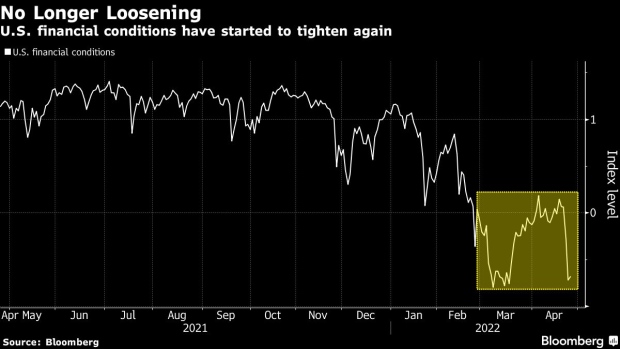Apr 27, 2022
Stock Rout Is Fed’s ‘Best-Case Scenario’ as Powell-Put Era Ends
, Bloomberg News

(Bloomberg) -- If you’re a Federal Reserve policy maker, the stock selloff of the last few weeks comes with a silver lining.
Financial conditions -- a cross-asset measure of market health from equities to fixed income -- have finally started to tighten over the past week in sympathy with the recent plunge in equities, led by richly priced technology companies.
That’s likely welcome news for Fed officials gathering next week to lift interest rates by an expected 50 basis points for the first time since 2000. In March, Chair Jerome Powell stressed that financial conditions are the mechanism through which monetary policy “reaches the real economy” -- and should be expected to contract as the central bank raises borrowing costs.
Given this policy goal, the now-12% drop in the S&P 500 this year combined with the plunge in speculative high-growth equities can be seen as a validation of hawkish monetary efforts to moderate the excesses of this inflation-lashed business cycle.
It all marks the formal end of the Powell put, or the longstanding belief that the central bank will alleviate every market stress with easier and easier policy.
“For the Fed, this is probably pretty close to the best case scenario -- you’ve had a tightening of financial conditions that has so far been pretty orderly,” said Dan Suzuki, deputy chief investment officer at Richard Bernstein Advisors. “Meanwhile, the correction in stocks has been in the frothier parts of the market and has not had much spillover effect into credit markets despite the crazy rate volatility.”
According to a Bloomberg measure, U.S. financial conditions have compressed to -0.73, near the tightest levels since 2018, excluding 2020’s coronavirus shock. The measure eased in the aftermath of the Fed meeting in March when policy makers kicked off the tightening campaign with a 25 basis-point hike -- undercutting their efforts to tamp down demand and inflation.
Now, markets are ever-less buoyant, with rate-sensitive megacap names bearing the brunt of this week’s selloff as investors brace for super-sized Fed hikes. The risk-off sentiment has permeated into credit markets, where spreads are widening back to March highs but remain not far off historic lows. Beyond the drawdowns in stocks and bonds, primary markets have tightened for newly public equities and corporate credit, according to Jefferies LLC.
“It is worthwhile noting that corporate bond issuance and IPO activity has cooled YTD,” Jefferies strategists lead by Sean Darby wrote in a report Tuesday. “Furthermore, companies seeking second round financing or running negative free cashflow have found the reception from financial markets much chillier than it was a year ago.”
Even so, the compression in financial conditions remains modest, according to SoFi’s Liz Young.
“We’re pretty much back to where we were after the early year correction and that correction wasn’t too bad considering the circumstances,” said Young, head of investment strategy at SoFi. “At least not bad enough to flag as a huge risk to financial conditions in the Fed’s eyes.”
All that suggests Powell and Co. will ultimately need to hike more than planned should the bull market in stocks and credit regain its vigor, per Columbia Threadneedle’s Gene Tannuzzo.
“Tighter financial conditions are the mechanism that reduces demand and ultimately slows inflation,” said Tannuzzo, the firm’s global head of fixed income. “If financial conditions don’t tighten and inflation remains high, in their eyes, they need to hike more.”
©2022 Bloomberg L.P.





